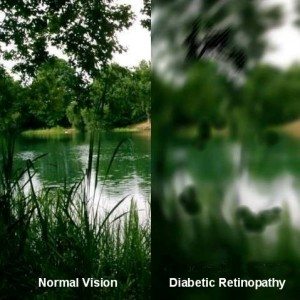In the United States, diabetes is the leading cause of blindness in people under the age of 65. It can cause cataracts, glaucoma and a host of other problems, but it’s main target is the small blood vessels in the retina.
Diabetic Retinopathy – A complication of diabetes involving abnormal blood vessels which nourish the retina of the eye.
 Blockage of the vessels can lead to the development of small pouches in the blood vessel walls (microaneurisms), leakage from the vessels (exudates), bleeding, swelling (edema) in the center of the retina, and even the growth of new blood vessels which are fragile and bleed easily, leading to scarring and decreased vision.
Blockage of the vessels can lead to the development of small pouches in the blood vessel walls (microaneurisms), leakage from the vessels (exudates), bleeding, swelling (edema) in the center of the retina, and even the growth of new blood vessels which are fragile and bleed easily, leading to scarring and decreased vision.
This devastating eye disease can only be found upon a thorough dilated eye examination. The examination is important because the disease can be treated and vision saved with prompt, in-officetreatments. Of course, if we don’t know about the problem we cannot treat it, so routine eye examinations are of the utmost importance to diabetics.
Intravitreal anti-VEGF injections can improve the vision of people with diabetic maculopathy. VEGF stands for “vascular endothelial growth factor”. It is one of the chemicals responsible for the growth of new blood vessels that form in the eye. Anti-VEGF medicines work by blocking this chemical and stopping it from producing the blood vessels.
Steroid injections may also slow diabetes-related eye disease.